Some jurisdictions have different requirements for wheelchair accessible toilet compartment size and configuration. It is strongly recommended to check with local codes. As an example, the California Building Code requires “a minimum 60 inches wide and 48 inches deep maneuvering space in front of the toilet.” Horizontal grab bars must be mounted on the rear wall and on the closest side wall or partition to the toilet. The ICC A117.1-2017 Standards require a vertical grab bar that is a minimum of 18 inches long be installed above the horizontal side grab bar.
The Large Wheelchair Accessible Toilet Compartment with side door access is a common end-of-the-restroom alcove layout. In-swing doors must not overlap the required 56 inches by 60 inches clear floor space at the toilet. This layout complies with the California Building Code because there is a maneuvering space minimum of 48 inches deep by 60 inches wide in front of the toilet.
The ICC A117.1-2017 Standards includes a new Alternate Wheelchair Accessible Toilet Compartment with 60 inches minimum width by 84 inches minimum depth.
The ambulatory accessible toilet compartment is used, in addition to a wheelchair accessible toilet compartment, where six or more fixtures, including toilets and urinals, are provided. However, there are exceptions to this rule. The 2010 State of Minnesota code requires an Ambulatory Accessible Compartment where there are two toilet compartments. The Ambulatory Accessible Toilet Compartment has a depth of 60 inches minimum. ADA Standards allow a range of 35 inches to 37 inches maximum width. In the ICC A117.1-2017 Standards, the width dimension is also 35 inches minimum to 37 inches maximum for existing and new buildings. Self-closing doors must not swing into the minimum required compartment area. Door pull hardware must be installed on both sides of the door near the latch. Horizontal grab bars must be provided on both sides of the toilet compartment. Additionally, the ICC A117.1-2017 Standards require a vertical grab bar, of 18 inches long at a minimum, be installed above the horizontal side grab bar on both sides of the toilet compartment.
Per the 2010 ADA Standards, toe clearance of 9 inches minimum above the finish floor is required for adults, and 12 inches minimum for children, under the front and one side of all wheelchair accessible compartments. The toe clearance must extend a minimum of 6 inches deep beyond one compartment-side and the front face of the toilet compartment, excluding supporting stiles or partitions. Toe clearance at the front is not required if the depth of the compartment is greater than 62 inches deep with a wall-hung toilet or 65 inches deep with a floor-mounted toilet. Toe clearance at the side is not required in a compartment greater than 66 inches wide.
In the ICC A117.1-2017 Standard, the toe clearance requirement is 12 inches high minimum for adults and children and must extend a minimum of 8 inches beyond the compartment front and on one side, exclusive of supporting stiles or partitions. Toe clearance at the front and the side is not required on compartments greater than 67 inches in depth and 68 inches in width. To avoid the need for toe clearance, increase the size of Wheelchair Accessible Toilet Compartment to 66 inches by 66 inches to comply with the 2010 ADA and ICC A117.1-2017 for Existing Buildings and to 68 inches by 68 inches to comply with ICC A117.1-2017.
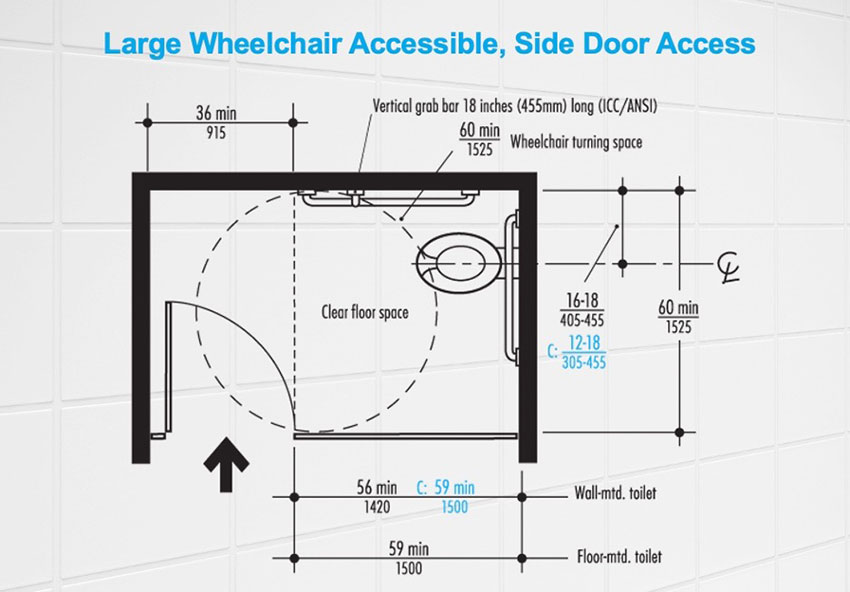
Image courtesy of Bobrick Washroom Equipment
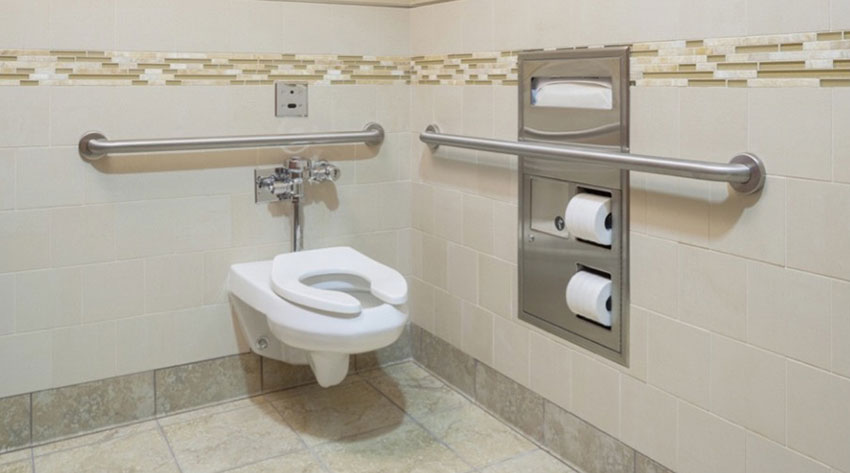
Photo courtesy of Bobrick Washroom Equipment
Toilets with lever controls and undercut bowls are recommended.
Compartment Door Requirements
Doors on all accessible toilet compartments must include door pull hardware and self-closers. There must be a clear width opening of 32 inches minimum with the door open 90 degrees. Out-swinging doors approached from the latch side must have an access aisle 42 inches wide minimum; other approaches require an access aisle up to 60 inches wide, at a minimum. It is recommended that all out-swinging doors should close completely, as a partially open door may encroach into the required maneuvering clearances and impede access.
Toilet Requirements
For compliance, toilets with undercut bowls are recommended. Flush controls such as levers must conform with standards for controls and operable parts and reach range requirements. In wheelchair accessible toilet compartments, flush controls must be located on the open side of the toilet.
The height of toilet seats above the finish floor must be 17 inches minimum to 19 inches maximum, measured to the top of the seat. Toilet seats cannot be sprung to return to a lifted or raised position.
Grab Bars
Grab bars with circular cross-sections must have an outside diameter of 1-1/4 inches minimum and 2 inches maximum and an absolute clearance of 1 ½ inches between the grab bar and wall or toilet partition panel. Non-circular profiles such as ovals and rounded rectangles are allowed. The maximum and minimum horizontal mounting heights of grab bars are set to the top of the gripping surface, not the grab bar centerline.
The horizontal sidewall grab bar next to an accessible toilet in a compartment must be a minimum of 42 inches long, located at 12 inches maximum from the rear wall, and extending 54 inches minimum. The 36-inch horizontal grab bar required to be mounted on the rear wall behind an accessible toilet must be located with a 24-inch minimum length required on the open side of the toilet centerline. The rear wall grab bar can be split to accommodate a high-rise flush valve; a 24-inch minimum length is required on the open side of toilet. The ICC A117.1-2017 Standards now require a vertical 18-inch-long minimum grab bar located 39 to 41 inches off the back wall, above the horizontal side grab bar. By using a 48-inch-long side wall grab bar, most installation compliance problems are eliminated.
Additional Toilet Accessories
Several accessories should be included in every toilet compartment. These include a toilet tissue dispenser, waste disposals, and toilet seat cover dispensers. All accessories must be located on a side wall or partition, nearest the toilet in accessible compartments, and just in front of the leading edge of the toilet to ensure universal access. Regardless of the location of dispenser outlets, no part of any accessory that projects from the wall or partition can be installed in a way that interferes with maneuvering space or access to grab bars. If mounted above grab bars, no part of a protruding accessory can extend closer than 12 inches to the top of the grab bar. The ICC A117.1-2017 Standard includes an Exception that allows recessed units behind grab bars with less than 1-1/2-inch absolute grab bar wall clearance as an alternative design to the 2010 ADA Standards.
Public restrooms are an essential building amenity and, as such, need to adapt to a wide range of human abilities. To ensure proper accommodation, prescriptive requirements mandate standards for both new and existing buildings. For design professionals to achieve their vision and better serve occupants, it is important to understand the impacts of these requirements. Understanding how to specify for accommodation can work in tandem with the desire for coordinated aesthetics, improved operating costs, hygiene, compliance, and sustainability.
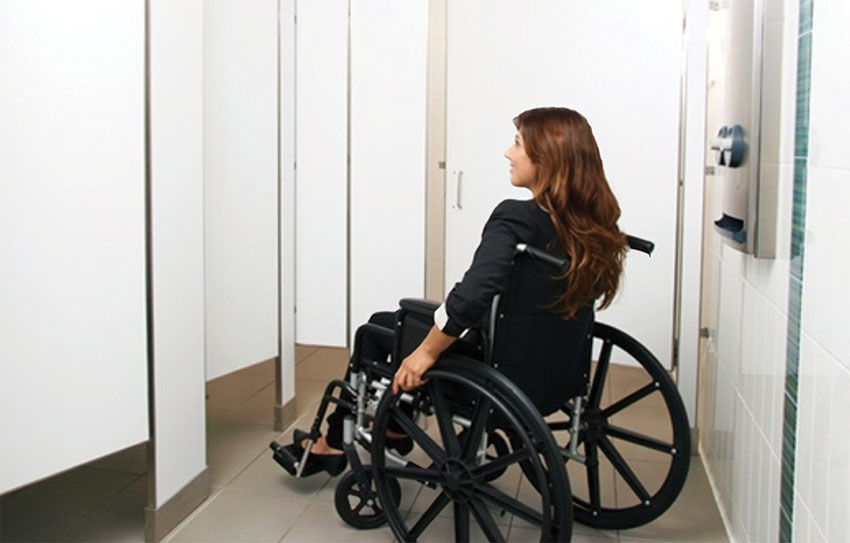
Photo courtesy of Bobrick Washroom Equipment
Today’s accessibility standards accommodate a diverse set of users.
Prescriptive Codes And Standards
Public restrooms are an essential feature of the built environment. They must also accommodate many diverse groups and be responsive to a wide range of abilities and disabilities. Though wheelchair access is a primary basis of design in the standards, accommodations in washrooms can benefit a wide range of users, including people with health problems, the elderly, children, and caregivers.
The Americans with Disabilities Act (ADA) is a federal civil rights law that prohibits discrimination against people with disabilities by ensuring equal access to goods and services. It recognizes inaccessible washroom facilities as a form of discrimination since inaccessible facilities can exclude participation in public activities or the workplace by people with disabilities. The Americans with Disabilities Act (ADA) sets the minimum requirements, both scoping and technical, for newly designed and constructed, or altered, state and local government facilities, public accommodations, and commercial facilities to be readily accessible to and usable by individuals with disabilities. For restroom design, this means some of each type of fixture or feature, as well as the installation location, must meet accessibility requirements contained in the 2010 ADA Standards for Accessible Design. In addition, many projects must also follow the provisions of the 2017 Edition of ICC A117.1, Accessible and Usable Buildings and Facilities, certified by the American National Standards Institute or ANSI.
The new ICC A117.1-2017 Standards, published in May 2017, will become widely effective as jurisdictions adopt this latest version. The 2021 Edition of the International Building Code (IBC) refers to ICC 2017 A117.1. As county, local, and state authorities adopt IBC 2021, they will be enforcing 2017 ICC A117.1. In recent years, states such as California, Hawaii, Massachusetts, and Texas have not adopted the A117.1 standard. Instead, these states have harmonized their accessibility standards with the 2010 ADA Standard or developed their states’ accessibility standards to exceed the minimum ADA requirements.
Because the 2017 ICC Standards will soon be adopted by many states and local jurisdictions, there will be significant jurisdictional overlap with the 2010 ADA Standards for many projects. The 2010 ADA standards and the 2017 ICC Standards are similar; however, there are some differences in the scope of their requirements and in technical specifications. Individual states may also have their own accessibility standards. When working on projects with ADA, ICC A117.1-2017, and state accessibility standards, the most stringent of the standards should be followed.
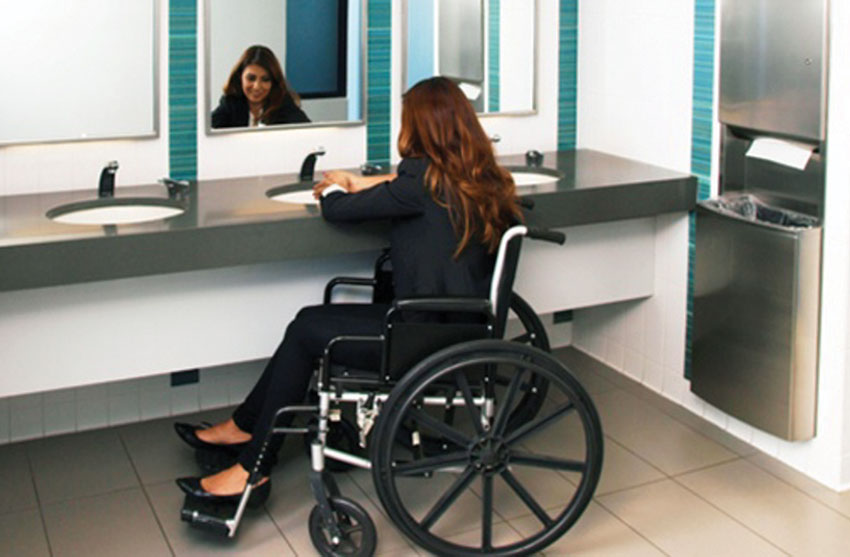
Photo courtesy of Bobrick Washroom Equipment
The Americans with Disabilities Act (ADA) sets the minimum requirements, both scoping and technical, for newly designed and constructed, or altered, state and local government facilities, public accommodations, and commercial facilities to be readily accessible to and usable by individuals with disabilities.
General Prescriptives
Accessibility standards compliance is founded on a set of “building blocks.” These “building blocks” include dimensional requirements stated as minimums and maximums.
The 2010 ADA Standards designate clear floor space to accommodate a single wheelchair. Wheelchair dimensions and movements are used as a primary source of design information for accessible restrooms in terms of amount of space and paths of travel. Clear floor space at lavatories, urinals, and baby changing stations must be positioned for forward approach. A portion of the clear floor space may be located under countertops, lavatories, or other accessories if the required knee and toe clearance is provided. Clear floor space at other restroom elements, such as paper towel dispenser and waste receptacle units, and hand dryers, can be positioned for both front and parallel or side approach. If properly centered in front of controls and operating mechanisms, the clear floor space will allow both left- and right-hand access.
Mounting heights for restroom accessories may vary within a facility, depending on the location of individual accessories. The fixed nature of the equipment imposes finite space requirements and particular limits on the reach ranges of users. To allow use by people with limited reach ranges, it is required that accessories, other than toilet tissue dispensers, be mounted with their operable parts, like dispensing mechanisms, start buttons, electronic sensors, coin slots, or dispenser openings, located no more than 48 inches above the finish floor.
In the state of California, the maximum height for operable parts is 40 inches, not the 48-inch maximum in the 2010 ADA and ICC A117.1-2017 standards. The operable portions of toilet tissue dispensers should be mounted no lower than 15 inches above the floor per the ADA. The ICC A117.1-2017 Standard limits the operable portions of toilet tissue dispensers to no lower than 18 inches. The ICC A11.7-2017 Standard has an Exception that allows dispensers that accommodate two rolls no more than 5 inches in diameter to be located 7 inches to 9 inches from the dispenser centerline to leading edge of the toilet. The dispenser outlet should be a minimum of 15 inches above floor. In the state of California, operable portions of toilet tissue dispensers should be mounted no lower than 19 inches above the floor.
Where accessories are mounted over obstructions such as counters, their operable parts must be located a maximum of 48 inches above the finish floor when the obstruction is 20 inches or less deep, and a maximum of 44 inches above the floor when the obstruction is 20 inches or more deep.
When determining the mounting location of restroom accessories, it is important to account for side and forward approaches. It is highly recommended that one set of each type of dispenser be located outside of the toilet compartment, on an accessible route for increased convenience.
When designing restrooms primarily for children’s use, select the dimensions that are most appropriate for the specific children’s age group for which the project is designed. Mounting heights for children vary depending on age. Ages are grouped as follows: children aged 3 and 4, 5 through 8, and 9 through 12 years. ADA offers recommended heights for each age group; however, these dimensions are not required standards.

Image courtesy of Bobrick Washroom Equipment
Height ranges of bathroom accessories.
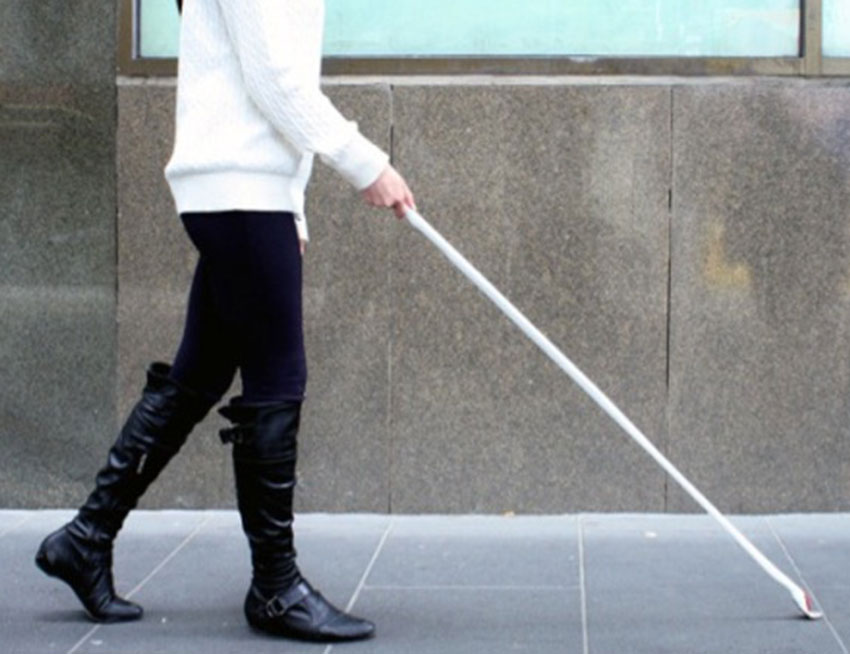
Photo courtesy of Bobrick Washroom Equipment
Accessible restroom design also enables users with visual challenges to navigate safely.
Incorporating Universal Design
Ensuring usability is not simply the domain of code or requirements. A universal design approach improves the accessibility of products, spaces, and building elements to ensure they are usable to the greatest extent possible by people of all ages and abilities. The objective is not to design or build for the “other,” that is, people with disabilities, but for each other – for everyone!
Over the past 60 years, the U.S. has seen growth in the numbers of two important groups: people with disabilities and older adults. A universal design approach for restrooms mainstreams products and eliminates radically different looking fixtures and accessories, as well as the non-inclusive stigma associated with different looking products.
While accessibility standards were created to principally benefit people with particular disabilities, demographic trends and experience have shown that environments built with accessible and universal design features often benefit a wide range of users, including people with stability and balance issues, children and people who are short or tall, people who are large or heavy, and even parents attending to their children using strollers. These restrooms are responsive to a wide range of ages and abilities, and they adapt well to the needs of those with sensory issues. For those users with visual challenges, a responsive restroom avoids protruding objects and increases lighting levels, helping those with low vision stay safe. Providing strobe lights on the fire alarm system helps alert people with hearing loss or those who are deaf. Family restrooms allow the ability to meet other patron needs such as diaper changing, adults with children, older individuals who need assistance, particularly from opposite gender caregivers, and transgender individuals.
Universal Design accommodation can be accomplished through mindful selection of fixtures and placement. Using the same product for everyone means offering a welcoming countertop with multiple accessible lavatories, as opposed to individualized lavatories with only one dedicated accessible lavatory. By positioning the same products differently, such as lowering the mounting height of all towel and waste units for accessible compliance, restroom accessories become universally usable, as opposed to asymmetrical restroom accessories, which limit usability for some.
After ensuring accessibility compliance, restrooms should be designed and maintained to support hygiene best practices. COVID-19’s effects served to emphasize design considerations that have been in practice through existing standards. Many of the same design standards that ensure accessibility also enable better hygiene. These strategies include selecting accessories with touchless operation, which enables use by all people while preventing the spread of germs through contact. Doorless entries ease access for all and help avoid possible microbe spread. Paths of travel, which add space for wheelchairs, also supply a physical waiting distance at lavatories, toilet compartments, and urinals.
Changes in the ICC A117.1 – 2017
For the first time, the 2017 ICC Standards make a distinction between some dimensional requirements when requirements are applied to new buildings versus existing buildings. The 2017 ICC Standards require larger clear floor space dimensions for new buildings, based on the increased size of three basic space requirements: wheelchair clear floor space, circular wheelchair turning space, and T-shaped wheelchair turning space. The 2017 ICC Standards have retained the smaller dimensions found in the 2010 ADA Standards and the ICC 2009 Standards for existing buildings.
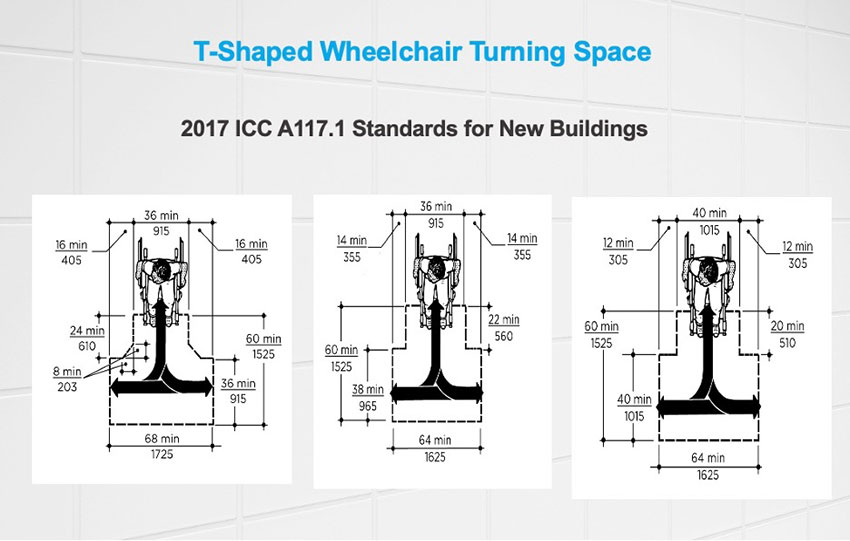
Image courtesy of Bobrick Washroom Equipment
The number of individuals who use wheelchairs has grown considerably in recent years, as have the variety of wheelchair types and sizes. The increase in the numbers of older adults, demographically, has also contributed to the growth in the number and variety of alternative mobility devices and scooters. Scooters have different sizes, use parameters, and can even require more space to maneuver when compared to wheelchairs. With the 2017 ICC Standards, accessibility requirements are now beginning to reflect these trends. Design professionals should take care to provide the extra space that larger mobility equipment devices require.
An aging society has contributed to another development in restroom requirements. The accessibility standards require the provision of ambulatory accessible toilet compartments to support the needs of individuals who are ambulatory but may require the use of a cane, walker, or crutches. Mounting locations and the proximity of equipment are important for people who use wheelchairs and who may have limited reach range. The design standards reflect these users’ needs in the mounting heights for common accessories, such as mirrors, paper towel dispensers, waste receptacles, soap dispensers, feminine hygiene product vendors, and toilet partition-mounted equipment, including grab bars, toilet tissue and seat-cover dispensers, and sanitary napkin disposals.
Significant changes in the ICC A-117.1-2017 Standards include increased size of the basic floor space requirements for new buildings. In the 2010 ADA and ICC A117.1-2017 for existing buildings there is no change in the wheelchair clear floor space, with a 30-inch x 48-inch minimum space delineated. In the ICC A117.1-2017 for new buildings, the wheelchair clear floor space increases to a 30-inch x 52-inch minimum.
A circular space allows a person using a wheelchair to make a 180-degree or 360-degree turn.
The 2010 ADA and the ICC A117.1-2017 requirement for existing buildings is unchanged, at a 60-inch minimum diameter circular space. For new buildings, the ICC A117.1-2017 requires a circular space that increases to 67 inches minimum diameter.
A T-Shaped turning space allows for a three-point turn. In the 2010 ADA, and the ICC A117.1-2017 standard for existing buildings, there is no change in the 60-inch x 60-inch minimum square with arms and a base set at 36-inches wide at a minimum. In the ICC A117.1-2017 Standards for new buildings, three new T-Shaped Turning Space options are included with different, larger configurations. These larger options are 60 inches by 68 inches and 60 inches by 64 inches with 36-inch, 38-inch, and 40-inch-wide bases. These larger options accommodate the new 30-inch by 52-inch Wheelchair Clear Floor Space.
A portion of the circular or T-Shaped turning spaces may be located under countertops, lavatories, or accessories, if the required knee and toe clearance is provided. The allowed knee and toe overlap clearance remains at 25 inches maximum in the 2010 ADA and ICC A117.1-2017 for existing buildings. The allowed knee and toe overlap clearance is restricted to 10 inches minimum in the ICC A117.1-2017 for new buildings.
The 2010 ADA and the ICC A117.1-2017 standards require both left- and right-handed facilities be provided in restrooms to the greatest extent possible. Providing clear floor space centered in front of controls and operating mechanisms will allow both left- and right-hand access.
Accessible Lavatories And Accessories
Lavatories are important features in public restrooms, providing convenient hygienic facilities for all people. At least one lavatory in each restroom must meet or exceed 2010 ADA Standards for accessible lavatories.
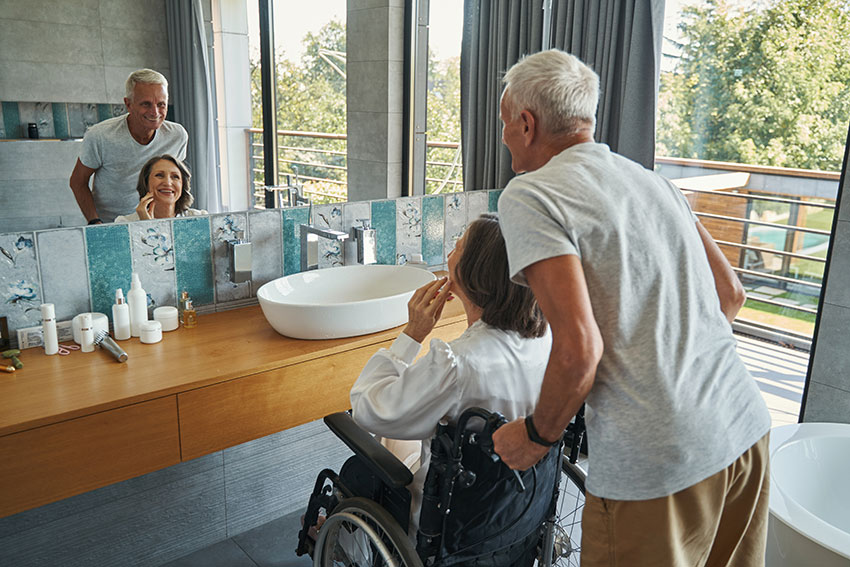
Photo courtesy of AdobeStock
Certain jurisdictions have differing rules on lavatory location. Make sure to understand the applicable codes in a project and follow the most stringent standard.
Regulations for Lavatories
If the lavatory is to be installed in a countertop, best design practice is to place it as close as possible to the front edge, so that it is accessible. An accessible lavatory must be installed with the front of the highest point, of either the rim or counter surface, at 34 inches maximum above the finish floor. It needs to provide a vertical knee clearance of 27 inches minimum from the bottom of the apron to the finish floor. The knee clearance must also extend a minimum of 8 inches under the front edge of the lavatory.
The required forward approach path must provide clear floor space in front of and under the lavatory at a minimum of 30 inches wide by 48 inches deep, per ADA and ICC A117.1-2017 for existing buildings. For new buildings, ICC A117.1-2017 clear floor space minimum is 30 inches wide by 52 inches deep. Required toe clearance depth underneath the lavatory can range from a minimum of 17 inches to 25 inches maximum. Toe clearance height of at least 9 inches above the finish floor must be provided for the full depth units. Water supply, drainpipes, and exposed surfaces under lavatories must be insulated or otherwise configured to protect against contact. There should be no sharp or abrasive surfaces. This is particularly important to prevent burns and other injuries to people who may have decreased sensation in their legs. One solution to prevent contact is to use wrapped pipes. Another design solution is to install a removable protective panel under the lavatory.
Certain jurisdictions have differing rules on lavatory location. In California, lavatories cannot be located in a toilet compartment. However, Florida requires an accessible lavatory be included in the Wheelchair Accessible Toilet Compartment. California limits the distance that clear floor space can extend under accessible lavatories to 19 inches. As always, it is vital to understand local accessibility requirements.
Regulations for Accessories
Designing restrooms to avoid protruding objects benefits those with disabilities or mobility challenges and those persons with low vision and the blind. Restroom accessories with leading edges between 27 inches and 80 inches above the floor shall protrude no more than 4 inches into a circulation path. This limitation is specifically designed to ensure detection by people who use a cane along the base of walls. Should the leading edge be at or below 27 inches, then the restroom accessory may project any amount, as long as the required minimum width of an adjacent clear access aisle is maintained. All floor-standing and surface-mounted units protruding more than 4 inches should be located in corners, alcoves, or between other structural elements. Fully recessed accessories are the recommended choice for eliminating protrusion from wall compliance issues and ensuring accessibility.
- Operable Parts: Restroom accessory controls and operating mechanisms include push buttons, valves, knobs, and levers. Controls must be operable with one hand, without tight grasping, pinching of the fingers, or twisting of the wrist, and should require less than 5 pounds of force. Controls should be centered over sufficient clear floor space for both left- and right-hand approaches.
- Mirrors: Mirrors located above lavatories or countertops must be installed with the bottom edge of the reflecting surface 40 inches maximum above the finish floor. Mirrors not located over lavatories or countertops must be installed with the bottom edge of the reflecting surface no more than 35 inches above the finish floor. A single full-length mirror is recommended in each restroom because all people can use it, including children.
- Soap Dispensers: Soap dispensers installed over lavatories must be mounted so push buttons or operable parts meet specified reach ranges. When the soap dispenser is mounted more than 20 inches from the edge of the counter, the soap dispenser mounting height is limited to 44 inches maximum above the finish floor. Lavatory-mounted soap dispensers and lever-handle faucets should be spaced far enough apart to avoid interference with their operations and so they are usable by persons using the accessible lavatories.
- Additional Accessories: Additional restroom accessories include paper towel dispensers, waste receptacles, hand dryers, and feminine hygiene product vendors. Paper towel dispensers, waste receptacles, and warm-air hand dryers should be conveniently located in an area that is accessible to people using wheelchairs, preferably adjacent to an accessible lavatory. Install the towel dispenser and waste receptacle unit with the paper towel dispenser opening, and operable parts, 48 inches maximum above the floor. Note that in California, maximum height of the operable part is set at 40 inches maximum above floor. Install hand dryers with the operable part, whether start button or sensor, at 48 inches maximum above floor; again, in California, 40 inches is the maximum height.
- Feminine hygiene product vendors are recommended in all women’s restrooms. Vendors with push-button operation mechanisms that can be activated with less than 5 pounds of force are the recommended choice for universally designed women’s restrooms.
- Baby Changing Stations: Baby changing stations are increasingly found in men’s and women’s restrooms and in single user “family” restrooms. While not required as a product category by the accessibility standards, baby changing stations are widely regarded as an important, or even essential, feature in many facilities, particularly those facilities that serve families. Baby changing stations need to be located with care to provide for both the needs of users while not preventing other restroom patrons, including people who use wheelchairs, from gaining access to other fixtures and dispensers in the restroom.
- Baby changing station installation and use must comply with the following ADA and ICC A117.1-2017 standards: mounting height to operate; clear floor space; controls and operable parts; force to open and close; working surface height, knee clearance height; and toe clearance depth. To maximize accessibility for all, position baby changing stations in corners. Add screens or floor-standing waste receptacles on open sides of the unit that extend below 27 inches above the floor for the full depth of the open changing bed to provide cane detection for patrons with low vision or the blind, alerting them to move away from an open baby changing station.
- Child protection seats are another newer adaptation in public restrooms to provide a safe, secure, and convenient location for a child, generally weighing up to 50 pounds. Unlike the baby changing stations, child protection seats should be installed inside a toilet compartment, on a side wall or partition, but never on the back of a door. This positioning provides visual and physical access. Like baby changing stations, they should be assessed for operability and reach in both the up and down positions. The bottom of the lowered seat should be no less than 15 inches above the floor, the minimum reach range distance allowed by 2010 ADA and ICC A117.1-2017 standards.
- Additional ICC A117.1-2017 Requirements: The ICC A117.1-2017 Standard requires altered installation heights and locations for paper towel dispensers and hand dryers. When at or near an accessible lavatory, where reach is obstructed, dispensers and dryers must be mounted on perpendicular walls adjacent to the accessible lavatories. The operable portions of these elements may need to be installed as low as 34 inches, depending on how far back from the front edge of a lavatory or counter a unit is mounted.
- The ICC A117.1-2017 Standards require that the soap dispenser controls and faucets that serve certain accessible lavatories, in large restrooms with six or more lavatories, need to be installed with a reach depth of 11 inches maximum. Only one set of these controls and faucets needs to be provided in restrooms that require them, regardless of the additional fixtures provided.
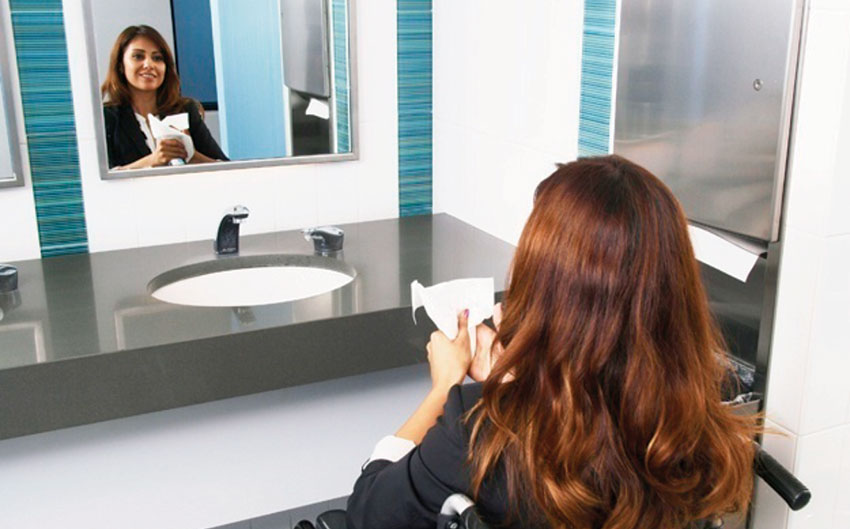
Photo courtesy of Bobrick Washroom Equipment
Paper towel dispensers, waste receptacles, and warm-air hand dryers should be conveniently located in an area that is accessible to people using wheelchairs, preferably adjacent to an accessible lavatory.
Accessible Toilet Compartments And Accessories
Accessible toilet compartments are required in all public restrooms. There are two basic toilet compartment designs that are shown in the standards: the Wheelchair Accessible Toilet Compartment and the Ambulatory Accessible Toilet Compartment. The wheelchair accessible toilet compartment accommodates people who use wheelchairs and who transfer onto and off a toilet using a variety of approaches. Three common transfer positions are diagonal, side, and perpendicular. The ambulatory accessible toilet compartment accommodates people who use canes, crutches, or walkers to assist their mobility.
General Compartment Standards
There are two styles of Wheelchair Accessible Toilet Compartments: standard front access units and large wheelchair accessible units with side door access. The ADA Standard front access Wheelchair Accessible Toilet Compartment mandates a 56-inch minimum depth for wall-hung toilets and a minimum depth of 59 inches for floor-mounted toilets. The minimum width is 60 inches. This minimum required space allows a person using a wheelchair to maneuver onto and off the toilet on the open side of the toilet. The toilet, positioned diagonally across from the door, must be offset on the back wall with the toilet centerline 16 inches minimum to 18 inches maximum from the side wall or partition.
Some jurisdictions have different requirements for wheelchair accessible toilet compartment size and configuration. It is strongly recommended to check with local codes. As an example, the California Building Code requires “a minimum 60 inches wide and 48 inches deep maneuvering space in front of the toilet.” Horizontal grab bars must be mounted on the rear wall and on the closest side wall or partition to the toilet. The ICC A117.1-2017 Standards require a vertical grab bar that is a minimum of 18 inches long be installed above the horizontal side grab bar.
The Large Wheelchair Accessible Toilet Compartment with side door access is a common end-of-the-restroom alcove layout. In-swing doors must not overlap the required 56 inches by 60 inches clear floor space at the toilet. This layout complies with the California Building Code because there is a maneuvering space minimum of 48 inches deep by 60 inches wide in front of the toilet.
The ICC A117.1-2017 Standards includes a new Alternate Wheelchair Accessible Toilet Compartment with 60 inches minimum width by 84 inches minimum depth.
The ambulatory accessible toilet compartment is used, in addition to a wheelchair accessible toilet compartment, where six or more fixtures, including toilets and urinals, are provided. However, there are exceptions to this rule. The 2010 State of Minnesota code requires an Ambulatory Accessible Compartment where there are two toilet compartments. The Ambulatory Accessible Toilet Compartment has a depth of 60 inches minimum. ADA Standards allow a range of 35 inches to 37 inches maximum width. In the ICC A117.1-2017 Standards, the width dimension is also 35 inches minimum to 37 inches maximum for existing and new buildings. Self-closing doors must not swing into the minimum required compartment area. Door pull hardware must be installed on both sides of the door near the latch. Horizontal grab bars must be provided on both sides of the toilet compartment. Additionally, the ICC A117.1-2017 Standards require a vertical grab bar, of 18 inches long at a minimum, be installed above the horizontal side grab bar on both sides of the toilet compartment.
Per the 2010 ADA Standards, toe clearance of 9 inches minimum above the finish floor is required for adults, and 12 inches minimum for children, under the front and one side of all wheelchair accessible compartments. The toe clearance must extend a minimum of 6 inches deep beyond one compartment-side and the front face of the toilet compartment, excluding supporting stiles or partitions. Toe clearance at the front is not required if the depth of the compartment is greater than 62 inches deep with a wall-hung toilet or 65 inches deep with a floor-mounted toilet. Toe clearance at the side is not required in a compartment greater than 66 inches wide.
In the ICC A117.1-2017 Standard, the toe clearance requirement is 12 inches high minimum for adults and children and must extend a minimum of 8 inches beyond the compartment front and on one side, exclusive of supporting stiles or partitions. Toe clearance at the front and the side is not required on compartments greater than 67 inches in depth and 68 inches in width. To avoid the need for toe clearance, increase the size of Wheelchair Accessible Toilet Compartment to 66 inches by 66 inches to comply with the 2010 ADA and ICC A117.1-2017 for Existing Buildings and to 68 inches by 68 inches to comply with ICC A117.1-2017.

Image courtesy of Bobrick Washroom Equipment

Photo courtesy of Bobrick Washroom Equipment
Toilets with lever controls and undercut bowls are recommended.
Compartment Door Requirements
Doors on all accessible toilet compartments must include door pull hardware and self-closers. There must be a clear width opening of 32 inches minimum with the door open 90 degrees. Out-swinging doors approached from the latch side must have an access aisle 42 inches wide minimum; other approaches require an access aisle up to 60 inches wide, at a minimum. It is recommended that all out-swinging doors should close completely, as a partially open door may encroach into the required maneuvering clearances and impede access.
Toilet Requirements
For compliance, toilets with undercut bowls are recommended. Flush controls such as levers must conform with standards for controls and operable parts and reach range requirements. In wheelchair accessible toilet compartments, flush controls must be located on the open side of the toilet.
The height of toilet seats above the finish floor must be 17 inches minimum to 19 inches maximum, measured to the top of the seat. Toilet seats cannot be sprung to return to a lifted or raised position.
Grab Bars
Grab bars with circular cross-sections must have an outside diameter of 1-1/4 inches minimum and 2 inches maximum and an absolute clearance of 1 ½ inches between the grab bar and wall or toilet partition panel. Non-circular profiles such as ovals and rounded rectangles are allowed. The maximum and minimum horizontal mounting heights of grab bars are set to the top of the gripping surface, not the grab bar centerline.
The horizontal sidewall grab bar next to an accessible toilet in a compartment must be a minimum of 42 inches long, located at 12 inches maximum from the rear wall, and extending 54 inches minimum. The 36-inch horizontal grab bar required to be mounted on the rear wall behind an accessible toilet must be located with a 24-inch minimum length required on the open side of the toilet centerline. The rear wall grab bar can be split to accommodate a high-rise flush valve; a 24-inch minimum length is required on the open side of toilet. The ICC A117.1-2017 Standards now require a vertical 18-inch-long minimum grab bar located 39 to 41 inches off the back wall, above the horizontal side grab bar. By using a 48-inch-long side wall grab bar, most installation compliance problems are eliminated.
Additional Toilet Accessories
Several accessories should be included in every toilet compartment. These include a toilet tissue dispenser, waste disposals, and toilet seat cover dispensers. All accessories must be located on a side wall or partition, nearest the toilet in accessible compartments, and just in front of the leading edge of the toilet to ensure universal access. Regardless of the location of dispenser outlets, no part of any accessory that projects from the wall or partition can be installed in a way that interferes with maneuvering space or access to grab bars. If mounted above grab bars, no part of a protruding accessory can extend closer than 12 inches to the top of the grab bar. The ICC A117.1-2017 Standard includes an Exception that allows recessed units behind grab bars with less than 1-1/2-inch absolute grab bar wall clearance as an alternative design to the 2010 ADA Standards.
Roll toilet tissue dispensers that allow continuous paper flow are required in all accessible toilet compartments. Dispensers that control continuous paper delivery should not be used. The 2010 ADA Standards require roll toilet tissue dispensers to be installed with dispenser centerline 7 inches minimum to 9 inches maximum in front of the leading edge of the toilet. The ICC A117.1-2017 Standards establish a different measurement procedure, locating the toilet tissue dispenser outlet between 24 inches minimum and 42 inches maximum from the rear wall of the toilet compartment.
Sanitary napkin disposals are recommended in all women’s toilet compartments for feminine hygiene waste. They should be within reach from a sitting position, and it is recommended they be mounted below grab bars. Toilet seat cover dispensers are an optional hygienic amenity that can easily be provided in all toilet compartments. The opening for toilet seat covers needs to be mounted between 15 inches and 48 inches above the floor, in an accessible location in relation to the leading edge of the toilet, per the 2010 ADA Standards, or from the rear wall per the ICC A117.1-2017 Standards. Recessed combination units installed on side walls or partitions with grab bars can organize and unify installations by incorporating several accessories at one convenient location, such as toilet tissue dispensers, toilet-seat-cover dispensers, and sanitary napkin disposals, improving accessibility. If compliance with the 2010 ADA Standard is a concern – for example, in the state of California─specify and install separate recessed or surface-mounted dispenser and disposal accessories a minimum of 1-1/2 inches below the horizontal grab bar.
Urinals, where provided, should include at least one wall-hung urinal installed with the rim 17 inches maximum above the finish floor. Urinals must be a minimum of 13-1/2 inches deep. The operable portion of the flush valve must be mounted no higher than 48 inches maximum above the floor, or no higher than 44 inches, if the urinal extends far enough to create at least 20 inches of reach. A minimum clear floor space of 30 inches wide by 48 inches deep, per 2010 ADA and ICC A117.1-2017 for existing buildings, must be provided to allow forward approach. To comply with ICC A117.1-2017 for new buildings a minimum clear floor space of 30 inches wide by 52 inches deep is required for forward approach.
Accessible bathing facilities for people with disabilities are required in a wide variety of buildings including hotels, athletic clubs, school gymnasiums and dormitories, parks and campgrounds, long-term care facilities, and hospitals. Accessible bathing facilities fall into two basic categories: individual shower compartments or combination tub and shower units.
Transfer shower compartments are the most common type of individual shower compartment used to accommodate people with disabilities. They must be 36 inches by 36 inches absolute inside dimensions, with a fixed or folding L-shaped shower seat mounted on a side wall opposite the shower head and controls. The 36 inches by 36 inches inside dimension addresses the reach and safety needs of adult users. Curbs may be installed, but they must be no higher than ½-inch.
In the 2010 ADA Standards and the ICC A117-.1-2017 Standards for existing buildings, the minimum clear floor space of 36 inches by 48 inches must be positioned starting outside the shower compartment, to allow proper wheelchair positioning for transfer to and from the shower seat. In the ICC A117.1-2017 for new buildings, a 36 inch by 52-inch minimum clear floor space is required adjacent to the open face of the transfer shower compartment.
Hand-held showers on a hose that can be used as both a fixed shower head and hand-held shower head are required in accessible showers. The hose must measure a minimum of 59 inches long. Use of an adjustable vertical slide bar for the hand-held unit is optional.
Roll-in shower compartments, also known as “Curbless Showers,” are functional for all users including people who use a castered shower chair for bathing. Roll-in shower compartments are required to be at least 30 inches deep by 60 inches wide. This measurement is derived from remodeling requirements and allows for the replacement of an existing tub with a roll-in shower compartment. Additionally, the ADA and ICC A117.1-2017 standards require that a minimum clearance of 30 inches wide by 60 inches long shall be provided adjacent to the open face of the standard roll-in shower compartment. This space may incorporate knee clearance under adjacent lavatories or countertops. Note that the California Building Code requires a minimum clearance of 36 inches wide by 60 inches long adjacent to the open face of the roll-in shower compartment. However, shower compartments set at the minimum size of 30 inches deep by 60 inches wide are often inadequate for containing water. For practicality, consider larger sizes to ease maneuvering and decrease water spillage, such as 36 inches by 60 inches, 48 inches by 60 inches and 60 inches by 60 inches. Curbs should be avoided or minimized. If it is necessary to include them, then curbs should be ½-inch high at a maximum.
Grab bars must be installed in all accessible bathing facilities. Horizontal grab bars in showers must be mounted 33 inches to 36 inches to the top of the gripping surface above the finish floor. Two horizontal grab bars or a single two-wall horizontal grab bar must be installed on the walls next to and opposite the folding shower seat in transfer shower compartments. Standard roll-in shower compartments must have grab bars installed 6 inches maximum from the corners. ICC A117.1-2017 Standards require that transfer and roll-in shower compartments must also have a vertical grab bar, 18 inches long minimum, mounted on the control wall, and 4 inches maximum from the front edge.
Combination Tub and Shower Units must have a horizontal grab bar mounted at the foot of the tub on the side wall that extends at least 24 inches from the front edge of the tub. They must also have two parallel horizontal grab bars, mounted on the back wall. The upper grab bar is mounted at standard height and the lower grab bar is mounted 8 inches to 10 inches above the tub rim. In tubs with a removable in-tub seat the back wall grab bar lengths are specified at 24 inches. Bathtubs with removable in-tub seats must have a fourth horizontal grab bar mounted at the head of the tub on the side wall that extends at least 12 inches from the front edge of the tub.
Permanent or folding shower seats are required by ICC A117.1-2017 Standards. Shower seats must be mounted with the top surface of the seat 17 inches to 19 inches above the finish floor. For both roll-in and transfer shower compartments, seats must have a 3-inch maximum space between the seat edge and compartment entry-opening, a larger permissible 2-½-inch maximum gap between the seat and seat wall and a 1-½- inch maximum space from side edge of seat to the adjacent wall. Previous standards required the seat to be full depth of a 36-inch by 36-inch compartment, which pushed the shower curtain beyond the entry of the compartment and allowed water to flow onto the floor outside the compartment. The new maximum 3-inch space allows the shower curtain to hang vertically, keeping water safely within the compartment. Roll-in type shower compartments with seats can now use a rectangular seat design or the previously required “L”-Shaped design. Upholstered, cushioned seats are preferred by many people with disabilities for their comfort, while water-resistant solid phenolic seats are vandal-resistant and more sanitary.
Shower accessory placement is also considered by the standards. Soap dishes should be placed on the same wall as the shower head and controls, where they are least likely to collect standing water. It is recommended that soap dishes be recessed and mounted 38 inches to 48 inches above the finish floor when installed in shower compartments. Alternately, they should be mounted between the grab bar and the rim of the bathtub.
Shower curtains work well as enclosures for all users, including people who use wheelchairs. If other types of shower enclosures are used, they should fold back completely out of the way so as not to obstruct transfer to shower seats or interfere with controls. They also must not incorporate a track along the floor or the rim of bathtubs.
Medicine cabinets installed in bathrooms must be mounted so the bottom edge of the reflective surface of the mirror is no higher than 40 inches above the finish floor. In the state of California, medicine cabinets must be located with a usable shelf no higher than 44 inches above the finish floor.
CONCLUSION
Prescriptive requirements set the design standards, reach ranges, space requirements, and layouts for both large, multi-compartment restrooms, individual toilet rooms, and private restrooms in commercial buildings. When designing restrooms, some of each type of accessible plumbing fixture, restroom accessories and toilet compartments and their installation location must meet accessibility requirements contained in the 2010 ADA Standards for Accessible Design and the 2017 Edition of ICC A117.1, Accessible and Usable Buildings and Facilities Standard. Knowing and utilizing current code requirements grants the ability to confidently lay out and specify accessible restroom accessories and toilet compartments for commercial, educational, and institutional building restrooms.
Amanda Voss, MPP, is an author, editor, and policy analyst. Writing for multiple publications, she has also served as the managing editor for Energy Design Update





















